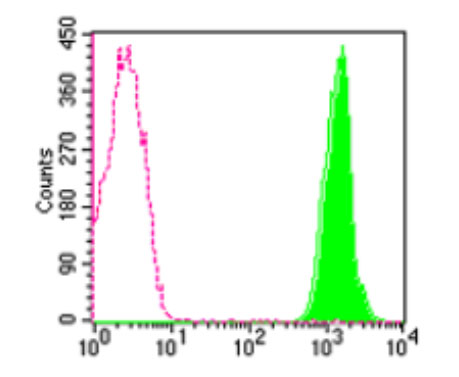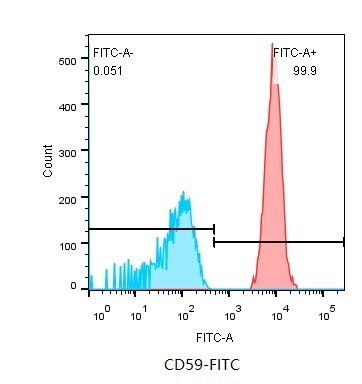
Mouse Anti-human CD59-FITC antibody
CD59 glycoprotein; CD59 molecule (CD59 blood group); 1F5 antigen; 20 kDa homologous restriction factor; MAC-inhibitory protein; Membrane attack complex inhibition factor; Membrane inhibitor of reactive lysis; MEM43 antigen; MACIF; 1F5; EJ16; EJ30; EL32; G
View History [Clear]
Details
Product Name human CD59-FITC Chinese Name FITC标记人CD59单克隆抗体 Alias CD59 glycoprotein; CD59 molecule (CD59 blood group); 1F5 antigen; 20 kDa homologous restriction factor; MAC-inhibitory protein; Membrane attack complex inhibition factor; Membrane inhibitor of reactive lysis; MEM43 antigen; MACIF; 1F5; EJ16; EJ30; EL32; G344; MIN1; MIN2; MIN3; MIRL; HRF20; MACIF; MEM43; MIC11; MSK21; 16.3A5; HRF-20; MAC-IP; p18-20; CD59_HUMAN. FITC anti-human CD59; Research Area Cardiovascular immunology Signal transduction Immunogen Species Mouse Clonality Monoclonal Clone NO. MEM43/5 React Species Human, Applications Flow-Cyt=20ul/Test
not yet tested in other applications.
optimal dilutions/concentrations should be determined by the end user.Theoretical molecular weight 9kDa Cellular localization The cell membrane Form Liquid Lsotype IgG2b Purification affinity purified by Protein G Buffer Solution 0.01M TBS(pH7.4) with 1% BSA, 0.03% Proclin300 and 50% Glycerol. Storage Shipped at 4℃. Store at -20 °C for one year. Avoid repeated freeze/thaw cycles. Attention This product as supplied is intended for research use only, not for use in human, therapeutic or diagnostic applications. PubMed PubMed Product Detail This gene encodes a cell surface glycoprotein that regulates complement-mediated cell lysis, and it is involved in lymphocyte signal transduction. This protein is a potent inhibitor of the complement membrane attack complex, whereby it binds complement C8 and/or C9 during the assembly of this complex, thereby inhibiting the incorporation of multiple copies of C9 into the complex, which is necessary for osmolytic pore formation. This protein also plays a role in signal transduction pathways in the activation of T cells. Mutations in this gene cause CD59 deficiency, a disease resulting in hemolytic anemia and thrombosis, and which causes cerebral infarction. Multiple alternatively spliced transcript variants, which encode the same protein, have been identified for this gene. [provided by RefSeq, Jul 2008]
Function:
Potent inhibitor of the complement membrane attack complex (MAC) action. Acts by binding to the C8 and/or C9 complements of the assembling MAC, thereby preventing incorporation of the multiple copies of C9 required for complete formation of the osmolytic pore. This inhibitor appears to be species-specific. Involved in signal transduction for T-cell activation complexed to a protein tyrosine kinase.
The soluble form from urine retains its specific complement binding activity, but exhibits greatly reduced ability to inhibit MAC assembly on cell membranes.
Subunit:
Interacts with T-cell surface antigen CD2.
Subcellular Location:
Cell membrane; Lipid-anchor, GPI-anchor. Secreted. Note=Soluble form found in a number of tissues.
Post-translational modifications:
N- and O-glycosylated. The N-glycosylation mainly consists of a family of biantennary complex-type structures with and without lactosamine extensions and outer arm fucose residues. Also significant amounts of triantennary complexes (22%). Variable sialylation also present in the Asn-43 oligosaccharide. The predominant O-glycans are mono-sialylated forms of the disaccharide, Gal-beta-1,3GalNAc, and their sites of attachment are probably on Thr-76 and Thr-77. The GPI-anchor of soluble urinary CD59 has no inositol-associated phospholipid, but is composed of seven different GPI-anchor variants of one or more monosaccharide units. Major variants contain sialic acid, mannose and glucosamine Sialic acid linked to an N-acetylhexosamine-galactose arm is present in two variants.
Glycated. Glycation is found in diabetic subjects, but only at minimal levels in nondiabetic subjects. Glycated CD59 lacks MAC-inhibitory function and confers to vascular complications of diabetes.
DISEASE:
CD59 deficiency (CD59D) [MIM:612300]: A deficiency resulting in chronic complement-mediated intravascular hemolysis, anemia, hemoglobinuria and thrombosis. Note=The disease is caused by mutations affecting the gene represented in this entry.
Similarity:
Contains 1 UPAR/Ly6 domain.
SWISS:
P13987
Gene ID:
966
Database links:Entrez Gene: 966 Human
Omim: 107271 Human
SwissProt: P13987 Human
Unigene: 278573 Human
Product Picture
References (0)
No References
Bought notes(bought amounts latest0)
No one bought this product
User Comment(Total0User Comment Num)
- No comment




 +86 571 56623320
+86 571 56623320
 +86 18668110335
+86 18668110335

